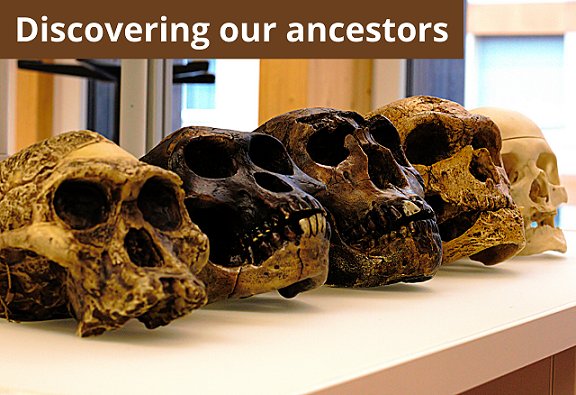IELTS Reading Practice – Sample 5

Answer these questions on the passage below.
Then, scroll down to the bottom of the page for the answers.
Complete
the sentences below.
Choose NO MORE THAN TWO WORDS from the text for each answer.
1) The location of the most recent human species
to be discovered was ……………………. .
2) Before the discovery of ancient Homo remains in South Africa, it was thought that our human predecessors originated in ……………………. .
3) The skull of homo species Paranthropus robustus is characterised by ……………………. .
4) In addition to human bones, the site at Drimolen was also found to contain ………………. .
5) By awarding ……………………. to attend a field school held at the Drimolen site each year, the team hope to interest students from the African continent in palaeoanthropology.
Reading passage:
Discovering Our Ancestors
Fossil find suggests Homo erectus emerged 200,000 years earlier than thought.
The human evolutionary path is complicated. It’s almost impossible to say exactly when we modern humans became “us”. This quandary is best articulated by the famous naturalist Charles Darwin in his book The Descent of Man:
“In a series of forms graduating insensibly from some apelike creature to man as he now exists, it would be impossible to fix on any definite point where the term ‘man’ ought to be used.”
The
understanding of modern humans’ own genus, Homo, has
taken many turns over the last century. Homo erectus, one of
our purported ancestors, was first discovered in Indonesia in 1891 by geologist
and anatomist Eugene Dubois. Since then, representatives of both this
species, and other Homo, have been found
across the world; for instance, in 2015, a new species of Homo, Homo naledi, was
discovered in South Africa. Another new Homo species, Homo luzonensis, was found more recently in the
Philippines in 2019.
These discoveries, combined, have led scientists to set Homo erectus‘ emergence at about 1.8 million years ago, with the oldest known record coming from Dmanisi, Georgia and an important slightly later record from the East African Rift valley. But our new discovery in South Africa’s Cradle of Humankind, which has just been published in Science, suggests that Homo erectus actually emerged 200 000 years earlier than we thought. We were part of a team from South Africa, Australia, Italy and the US that discovered a Homo erectus cranium which has since been dated to almost 2 million years ago.
This is a hugely important find. It reasserts that Homo erectus’ origins are in Africa, not Asia. Our discovery suggests, though, that Homo erectus likely did not evolve in eastern Africa as so often thought but perhaps somewhere else in Africa, or potentially in South Africa itself. More evidence is needed before firm conclusions can be reached, of course. But the South African find means that the Drimolen fossil site, where we made the discovery, could represent an important shift in the simple narrative that all early species of human ancestry are East African.
The Drimolen Fossil Hominin site in the Cradle of Humankind, northwest of Johannesburg, has been excavated since its discovery in 1992. The site is best known for its Paranthropus robustus, another ancient hominin species with massive teeth, as well as some early Homo fossils. The most famous specimen from Drimolen is the most complete skull of Paranthropus robustus ever discovered, DNH 7. It was here that members of our team found the fossil cranium that has been named DNH 134. Its nickname is Simon, named for the site technician whose contribution to the team was immeasurable. Simon Mokobane sadly passed away in 2018, but his expertise, unwavering support and fossil knowledge will forever be remembered.
In 2015, during the Drimolen Field School, a student named Richard Curtis began excavating an intriguing, but highly fragmented specimen. At first, no one was sure what it was from but in-field reconstructions quickly revealed that it was a hominin cranium. We used a battery of dating methods, including Uranium-lead dating on the flowstones, Uranium-Series Electron Spin Resonance on fossil teeth and Palaeomagnetism on sediments. Each of these complimentary techniques helped to establish a very narrow age of 2.04-1.95 million years for the whole Drimolen Main Quarry and the fossils found in it, including DNH 134.
DNH 134 is extremely significant. Its discovery and dating mean that the story of Homo erectus and its journey out of Africa is more complicated than previously thought. Also, we know too that South Africa played a seminal role in this key species that ultimately led to us.
Work will continue at the Drimolen site. We aim to continue excavating using a new method where our efforts are focused along the breccia (fossilised rock with fossils in it). This has proved fruitful with not only the discovery of DNH 134, but also a male Paranthropus robustus skull as well as a number of other hominin remains we are still studying. The site also has a wide variety of animal fossils from both extinct and living species, all of whom add to the overall story that we aim to build about how our ancient ancestors lived.
We will also continue to encourage young palaeoanthropologists from across the African continent to get involved in excavations. The site hosts an annual field school with international partner institutes and offers full scholarships exclusively to students from African countries, with South Africans having first preference. The idea behind this is to ensure that researchers from the continent and country are at the forefront of future discoveries that add to the human story.
Source: The Conversation. Authors: Stephanie Baker, Angeline Leece, Jesse Martin, Matthew Caruana, Prof. Andy Herries, Renaud Joannes-Boyau
Answers
Scroll down for the answers.


Answers:
1) the Philippines
2) East Africa
3) massive teeth
4) animal fossils
5) (full) scholarships
To learn How to Answer Sentence Completion Questions, click this link.
Like this page?
More IELTS Reading Practice Samples
Here are a few examples of the many practice activites I've created:
Sample 1 – What matters most when speaking a new language
Sample 2 – Fire evacuation plan (GT)
Sample 3 – Climate change and loss of biodiversity
Sample 4 – The wasp queen
Sample 5 – Discovering our ancestors
Sample 6 – Telecommunication - undersea cables
Sample 7 – Biodiversity
Sample 8 – Mining asteroids
Sample 9 – Dress Code Policy (GT)
Sample 10 – How to fight desertification & drought
To see the full list of practice samples, click this link:
›



